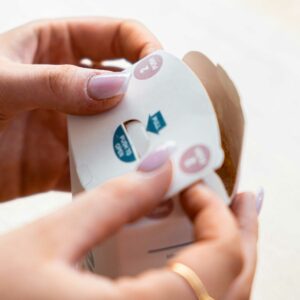A recent Sustainability Trends in Connected Packaging webinar delved into the dynamic realm of sustainable packaging trends, featuring prominent industry figures Cyril Drouet and David Landsberg. The session provided a comprehensive overview of sustainability in packaging, the rise of connected packaging, and the pivotal role of consumer perception.
Key Points Explored
Environmental Concerns and Consumer Preferences: The conversation highlighted the dual drivers behind the push for sustainable packaging – environmental concerns and evolving consumer preferences. Legislation changes and market shifts have propelled brands to prioritize eco-friendly packaging solutions.
Connected Packaging’s Role: The discussion centered on the pivotal role of connected packaging in fostering sustainability. Through QR codes, NFC, or RFID tags, consumers gain access to essential information about a product’s sustainability, recycling instructions, and sourcing details, promoting transparency and informed decision-making.
Consumer Perception and Behavior: Recognizing the informed and discerning nature of modern consumers, the webinar stressed the vital role of consumer awareness in driving the adoption of sustainable packaging. Consumers increasingly prefer brands that align with their eco-conscious values.
“Modern consumers are now more environmentally conscious than ever before. Several studies show that consumers prefer products and brands that demonstrate a commitment to sustainability. Shoppers are actively seeking out products with eco friendly packaging that aligns with their values. Brands that recognise this trend can gain a competitive advantage by adopting sustainable packaging practices. In fact, a recent McKinsey study shows that those brands are growing at about 10% faster.” – Jenny Stanley
The Good Cup’s Revolutionary Approach: Cyril Drouet shared insights into the Good Cup, a groundbreaking product designed to revolutionize traditional paper cups. The cup’s innovative design eliminates plastic components and utilizes compostable materials, ensuring minimal environmental impact.
“The idea was when I started my own business five years ago was to revamp traditional packaging, and the first one is to revamp the traditional paper cup as we all consume coffee dramatically across the world. The idea was to remove the plastic lid and find about something else. But we didn’t stop there. We didn’t stop at just removing the lid. We also removed the plastic liner inside.” – Cyril Drouet


Consumer Feedback and Trust-Building: Utilizing connected packaging, consumers were prompted to scan the QR code on the Good Cup or a billboard near the coffee collection point. Upon scanning, consumers were directed to answer questions regarding the cup’s usability, such as ease of opening and closing, perceived security while drinking, and overall drinking experience with the paper spout compared to conventional plastic ones. This facilitated a streamlined and quick process for consumers to provide their feedback.
Innovations in Sustainable Materials: The webinar spotlighted various innovations in sustainable packaging materials, including Microfibrillated Cellulose and Nano Cellulose, mentioned by Cyril Drouet. These alternatives aim to replace traditional plastics, utilizing waste materials and compostable components to minimize environmental impact.
Brand Transparency and Loyalty: The webinar highlighted the importance of brands being transparent about their sustainability efforts. By effectively communicating these initiatives and engaging consumers through gamification and concise information, brands can build trust and loyalty.
David Landsberg shared his valuable insights on the need for brands to be proactive and transparent in their claims, rather than greenwashing, as consumers are now more educated. Also, David’s view is that connected packaging can be used to gamify and reward consumer engagement through incentives, in order to share small bits of information effectively.
Multiple examples of utilizing connected packaging to promote a brands’ sustainability initiatives were mentioned, and here’s one that Appetite Creative worked on with Banga.
The game not only entertains players but also contributes to a local charity with every play. Through this interactive game, customers gain valuable insights into recycling beverage cartons while deepening their understanding of the brand. Additionally, the game hosts an educational section that highlights the environmental benefits, fostering awareness and knowledge among players about sustainability and eco-friendly practices.

Thanks to the fantastic audience for the great questions! Here are some that were asked and answered by the panelists:
is QR coding, especially for gaming, made for all FMCG categories? Or is it more adapted for “young consumers”?
David Landsberg: “I think that during Covid, we all got very used to QR codes. Certainly in the UK, certainly in Western Europe. I think that QR codes are now part of everything that we do so it’s not just young people – I think all age groups.And of course, the more QR codes are put out there, more people are going to be educated.”
In general how open are brands to changing their packaging with new QR codes to include sustainability messsaging in terms of their costs, logistics of replacing on shelves etc?
David Landsberg: “The issue with big brands is that they are very slow – it’s a very long slow process, but the interest has been fantastic and I think there is a real appetite now for brands to understand that if they are not doing anything, they are going to be left behind.”
Conclusion
The webinar concluded by stressing the synergy between sustainability, consumer engagement, and innovative packaging solutions. Through connected packaging, brands can effectively communicate their commitment to sustainability, fostering consumer trust and paving the way for a greener future.
